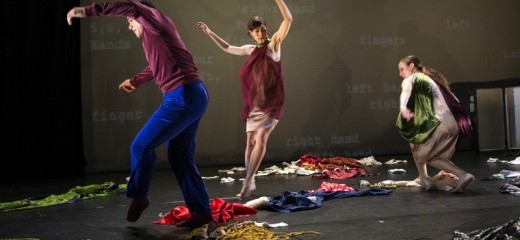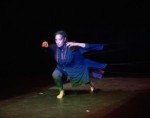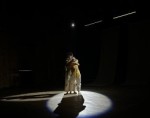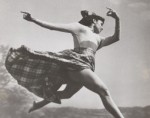
Photo: Steve Gunther
Critics' Conversation: Lionel Popkin’s "Ruth Doesn’t Live Here Anymore"
by Jonathan Stein and Lisa Kraus
Lisa Kraus: What do you think about dance or performance as a way of chewing on big questions, in this case cultural appropriation and how we relate to a historical figure?
Jonathan Stein: I think Popkin is taking on big history and big ideas through his personal experience and exploration of his South Asian/Indian roots. His mother is Indian. His last work which
I wrote about for TD a few years ago,
There is an Elephant in this Dance, is centered around the Ganesh elephant mythology. So he’s exploring his Indian cultural roots and addressing the mega-historical figure of Ruth St. Denis, one of the great progenitors of modern dance. This allows him to explore his own ambiguities in dealing with the historic past and these so-called big ideas.
LK: Do you find it effective how he’s doing that?
JS: I think there’s a lot of appeal there. I was left with a sense of incompleteness walking away from the piece and maybe with the paramount difficulty of addressing these issues of appropriation of an exotic culture, of dealing with this major figure of American dance. But I appreciated seeing his ambivalence, irony with a kind of homage mixed with humor. This carried me for most of the work. What do you think?
LK: I asked the question because I’ve run up against this before, where if I have a particular association with the figure that’s conjured I’m almost a reactionary watcher. Like, I want something “authentic”: the feel of that person. St. Denis was concerned with the spiritual. It wasn’t simply a matter of the steps she took on. There was a reason why she was attracted to the dance from these other cultures. Putting on the trappings of those provided a medium for her to connect with something else that was not really seen onstage very much. She and Isadora were both going deeper with dance and using the medium of other cultures—for Isadora it was Greece and for St. Denis it was the East—in order to do that, and I saw that reflected not at all.
JS: I agree with you and that may pinpoint my sense of unease or incompleteness with it. In some way it’s too easy a slam to deal with that theatricality of her past and effusive expressiveness. St. Denis did foster that next generation of Martha Graham and Charles Weidman and Doris Humphrey and Pauline Koner. I think that there is, from the little I know about St. Denis, that spirituality which was authentic. There may have been something “unauthentic” in her appropriation that she might not well have understood. In fact there’s this anecdote that she was first inspired by seeing a cigarette ad of the Egyptian goddess Isis and had an epiphany from that! And obviously she appropriated from Japan, from India, from Native American culture, yet it seems as I think you’re suggesting that there was a real spirituality that she connected with and made her own. And yes I think the Popkin dance only hints at it.
I see this real wrestling on Popkin’s part and ambivalence to St. Denis. There is a clear, real hard-edged hostility.He uses her own choreographic notes which are put on a video screen and I think he at one point says I’m going to treat these choreographic notes as she treated other cultures. Of course that’s by his ignoring those notes as he suggests she ignored these other cultures. That’s a fairly hard reaction. At the same time he does pay homage to her and even homage to that spirituality as when we see a ghostly presence on a video screen of Carmen DeLavallade dancing a 1906 St. Denis piece, Incense, while Carolyn Hall and Emily Beattie are onstage, gliding and swirling on the floor, with their arms covered in long silky gloves in red blue and green in subdued light. Their undulating arms seemed like underwater organic plants. This generated an unworldly mystery. There was in that scene some connecting with that spiritual presence of De Lavallade dancing that early St. Denis work.
JS: Irony is the quintessential post-modern take on the world. What do you think of Popkin’s use of irony in this work?
LK: If something is being poked fun at you do want to feel that it’s being given serious regard as well which has to do with what we were speaking about just now. But I think his humor is very appealing. When he says in the section you were referring to before, “we treated her score in the way that we chose” there’s a lot of humor in the gap between what St. Denis was picturing for herself and what they ended up doing: scootching along on their sitz bones, all in unison, or rolling back and forth on each other on the ground. It’s a relationship to body that she never would have conceived of. That was really fun.
Also in terms of his language it was obviously carefully scripted and yet delivered as if matter-of-fact. That was pretty effective. It brings up vaudeville where St. Denis herself began. Vaudeville is schtick and small bits and that was echoed in this performance, a string of many small and discrete scenes. It felt very appropriate in that format to come through with a quip or to have a zinger at the end of a short speech. I also wondered whether it was that format that prevented me from feeling like he was chewing a little more fully on the materials that he was engaging.
JS: I think that his contemporary sense of irony really might have been some obstacle to that level of understanding of spirituality. But his humor is a winsome quality.
Popkin is living and teaching at UCLA and I think he plumbed the archives in Los Angeles where she lived the latter part of her life, passing away in 1968.
One of her notes he put on the video screen referenced the feeling of a “poetic love mood.”Around that point Emily Beattie is standing on the horizontal plane of Popkin’s back. That’s hardly an image of a poetic love mood and suggests instead a kind of lonely domination. Popkin muscles his back into a platform for Beattie to stand on, referencing St. Denis’ note about “sensuous muscles of the back,” bringing a lot of humor into his irony.
LK: That section was the most interesting for me structurally because it recurs, as though he was trying to set up an image that would stick, but he kept having it fall apart. She must have gotten up on his back three or four times. It became aspirational, like “I’m going to manifest this mood but it’s not maintainable.” I found that fascinating.
LK: How do you respond to Popkin’s layering multiple elements and media within this piece?
JS: I think he’s a real master at this. He uses lots of elements and there’s a really expert weaving of them, including narrative. I welcomed breaks where he spoke in a Brechtian way directly to the audience. He often uses text on a video screen in different fonts and the like. There was a little overdoing of that, listing every city that St. Denis appeared in. But the music elements were really strong. Two major avant-garde musician/composers played—Guy Klucevsek and Todd Reynolds. The music had this subduing caressing quality that worked really well with everything in the piece. I loved the costumes which at various points were strewn and tossed on the floor and were collected with a leaf blower that reappeared a few times. The strewn costumes reflected that hodgepodge eclecticism of St. Denis’own sources of inspiration.
At one point Popkin wraps himself up in a sari-like length of cloth that really transforms him into a graceful mysterious figure that, for me, demonstrated the seductiveness of the exotic. He was spoofing this with post-modern irony but was also seductive to a contemporary eye in that wrapping. His irony was buried under that silvery gray sheath of fabric.
LK: And he says that the saris came from his mother so there’s another layer there. It was interesting before seeing the show to look at a few video clips, and recognize how important fabric was to St. Denis’ art. This is something he completely picks up on and works with. In her time that was true of all of them: Loie Fuller, Isadora. The way movement flows into fabric has been used all around the world—the Chinese have long sleeves and all that.
JS: I think that was really embodied in the Carolyn Hall solo which was a reference to the “skirt dance.” St. Denis in her youth in the 1890’s did these skirt dances as they were called at dime museums and vaudeville houses. These dances revealed the bare legs of dancers, which was a fairly radical act at the time.
All these costumes referenced the major role that costumes played for St. Denis and all the dancers that you mentioned and theatricality of movement that emanated from that.
Then here there’s this wonderful Popkin humor when during the solo you have Beattie and Popkin darting in and out of the wings almost mimicking Hall’s phrases.
LK: Lionel danced with Trisha Brown and I saw that as a reference to her Glacial Decoy where the dancer onstage pulls dancers on from the wings as she moves into the space and then they dance in unison. Later in that dance she’s doing this circular sliding motion which literally is at the end of Decoy. I’m not certain that that’s what Lionel was doing but had a feeling that’s what I was seeing.
JS: I have one more question. Do you know what the heck St. Denis meant when she said in her choreographic notes “Salaam to the right”?
LK: That was in her choreographic kit. The notion that you could purchase a kit in order to reproduce a St. Denis dance—it’s kind of a beautiful concept. I figure people at that time knew what it meant if she had no further explanation. I assumed that it meant a devotional kind of bow.
JS: I guess a contemporary kit must be YouTube and, somewhere there, we’ll find some equivalent for “Salaam to the right.”
OK, that was terrific.
LK: Yes that was fun!
Lionel Popkin’s Ruth Doesn’t Live Here Anymore, The Painted Bride, March 8-9.
By Jonathan Stein
April 2, 2013











